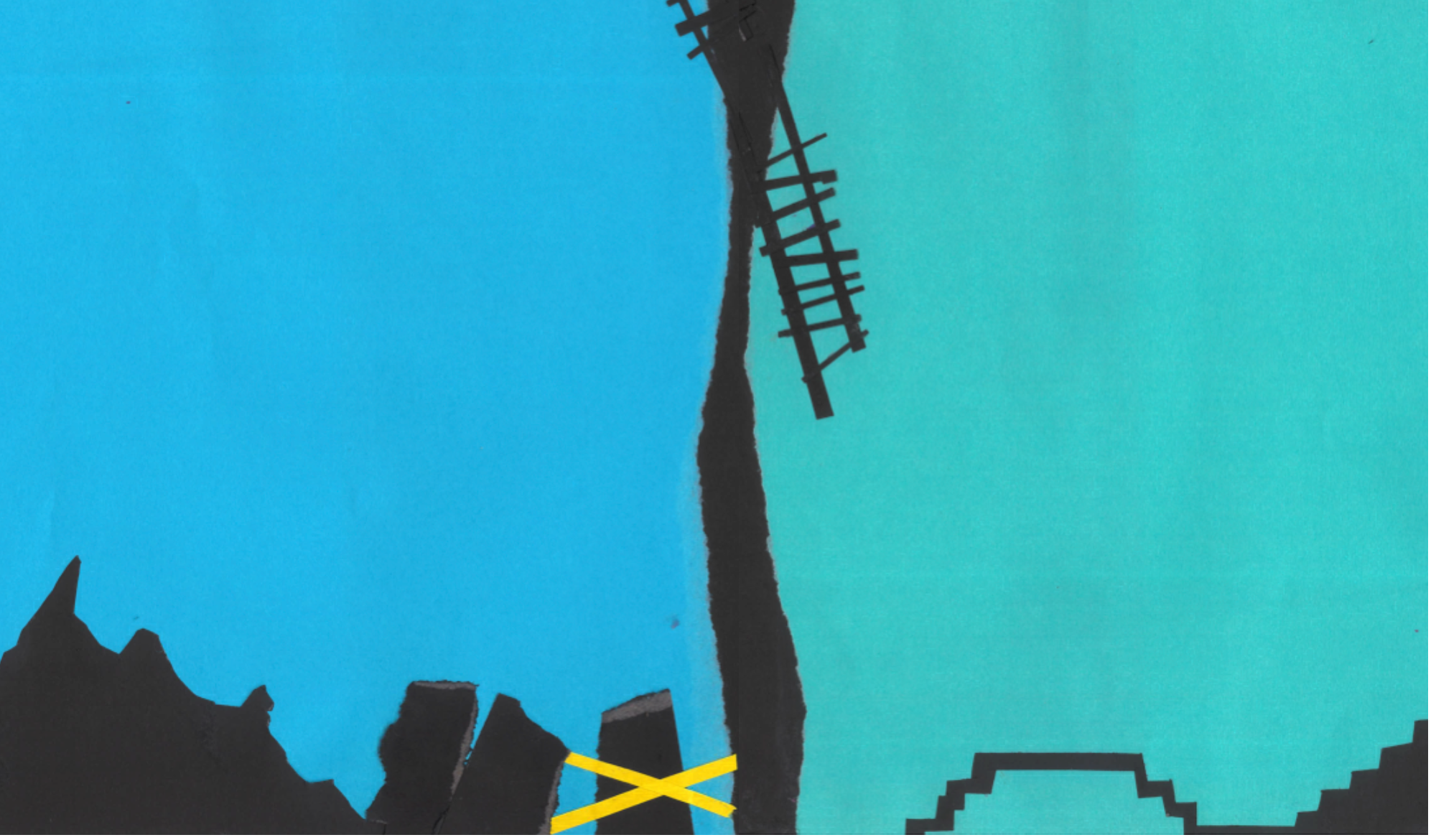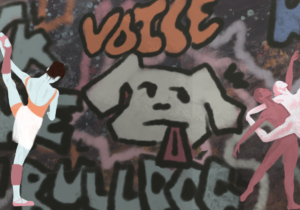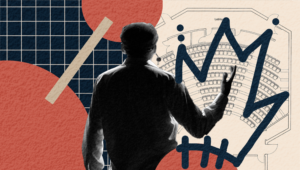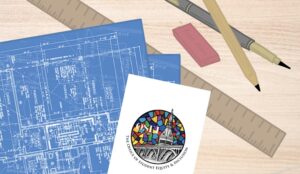Soren Anderson (SFS ’28) stood patiently at the exit from White-Gravernor Hall after class. The door didn’t have an Americans with Disabilities Act push button, and Anderson, who had recently sprained his ankle, couldn’t open it from the inside while on crutches. Instead, he had to wait until another student came through, opening the door for him, before he could continue.
When Anderson sprained his ankle a few weeks after transferring to Georgetown, he didn’t think that mobility barriers would upend his life. However, since then, he’s found that even basic travel around campus is difficult.
“I have a 10-minute passing period to go from second-floor ICC [Intercultural Center] to fourth-floor Walsh, which is tough when I’m not on crutches, impossible when I am,” Anderson said.
With construction on Tondorf Road and Copley Lawn, students have become increasingly aware of the lack of accessible routes on campus. However, for students with mobility challenges, Georgetown’s physical inaccessibility extends far beyond recent construction, raising concerns around on-campus accommodations and the student body’s attitude toward people with disabilities.
Anderson’s story is just the tip of the iceberg regarding access on campus. His condition is temporary, but for some Georgetown students, these are issues they face daily.
Everyday barriers
Mobility restrictions are all over campus. Georgetown’s old infrastructure, construction blocking multiple pathways, and hilly terrain make navigating the Hilltop difficult, according to Natalie Gustin (SFS ’26), a physically disabled student who uses mobility aids most of the time and an academic assistant at the Disability Cultural Center (DCC).
Beyond obvious access issues like uneven paths, myriad other barriers exist, including bookshelves in Lauinger Library that aren’t far apart enough to accommodate a mobility wheelchair and constantly malfunctioning elevators, Gustin said.
“This campus was not built for disabled students,” Gustin said. “There’s still so much work that needs to be done in terms of physical accessibility.”
Other students agree with Gustin. Georgetown’s most recent Campus Climate Survey from 2020 revealed that only 12.4% of undergraduates agreed or strongly agreed that the Georgetown campus was physically accessible to students with disabilities.
Social, pre-professional, and academic challenges
Gustin said that campus’s inaccessibility affects her academic and club life. She misses out on instructional time from being late to class and often can’t attend cultural or club events.
Accessing the cultural affinity houses off campus is nearly impossible for students with mobility issues, according to Gustin. In Spring 2025, GUSA announced that it secured funding for ramps accessing the affinity houses, which can only be reached by climbing up a short flight of stairs. However, a university spokesperson wrote to the Voice that Planning and Facilities Management “found the existing ramps did not meet code requirements.” The university has offered to reimburse GUSA for the ramps it purchased. Without ramps, Gustin said that disabled students of color cannot access valuable cultural resources.
Georgetown’s mobility barriers also impact physically disabled students’ social lives, said Paige Benish (SFS ’28), a physically disabled student who uses a wheelchair.
“You can’t really go to parties,” Benish said. “And if you do go to that party, you’re going to be stared at, you’re going to be talked to differently.”
The social implications of mobility barriers take a toll on disabled students, Benish told the Voice. Even something as everyday as a doorframe can determine if Benish and other physically disabled students are able to participate in a social event or club meeting, Benish said.
And, for Benish, constantly not being able to attend things and get places in a reasonable amount of time, or at all, is challenging.
“If you have to spend your day-to-day just exhausted and frustrated because everything doesn’t work—every door is broken, every elevator is broken—it’s tiring,” Benish said.
Administrative barriers
On top of impacting their social, pre-professional, and academic lives, physically disabled students told the Voice that it’s difficult to navigate administrative systems, especially as they try to access necessary accommodations through the Academic Resource Center and Residential Living.
Accommodation requests require proof for approval. To get the necessary documentation, Gustin had to miss a day of classes to travel to a doctor’s office. The financial and physical costs can limit accessibility for low-income students, Gustin said.
Benish faced a similar situation when they requested Americans with Disabilities Act (ADA) accessible housing in Spring 2025.
“They want doctor’s notes to prove that you’re in a wheelchair,” Benish said.
“Can’t you just use your eyes? Talk about administrative burden.”
Benish spent several weeks waiting for their request to be approved.
Although they received a wheelchair-accessible housing unit, Benish cannot physically get into their dorm with a wheelchair because of the narrow hallway and the arrangement of furniture. Benish does not have to use their wheelchair daily, but when they do need to use it, they have to ask their friends to pick them up and move them into their room.
“Accommodations are not a luxury,” Benish said. “They’re something I need to function.”
Gustin also said that implementing more seamless accommodation systems could make Georgetown more accessible. Colleges across the country have also implemented disability justice-based accommodation systems that eliminate the stringent requirements to prove one’s disability. For example, SUNY Cortland makes accommodations decisions primarily based on students’ self-reports about their experiences.
Beyond campus
These problems extend beyond the Hilltop. The Georgetown neighborhood’s historic buildings, cobblestone streets, and staircases make it virtually impossible for students in wheelchairs to go off campus, effectively forcing them to stay within the “Georgetown bubble.”
Georgetown built accessible spaces throughout the Capitol Campus, according to the university’s website. However, students with disabilities said that travelling between the campuses can be prohibitively challenging.
Benish originally wanted to participate in the Capitol Applied Learning Labs program at the Capitol Campus. After frequently waiting one or two hours for a GUTS bus with a working lift, they decided to stay on the Hilltop.
A university spokesperson wrote to the Voice that Georgetown is committed to ensuring an accessible and inclusive campus.
“We have made significant progress expanding accessibility and it remains at the forefront of campus planning for facility improvements and construction,” the spokesperson wrote.
A self-fulfilling prophecy
Students with disabilities worry that the lack of mobility access is a self-fulfilling system, according to Gustin. Because Georgetown lacks accessible infrastructure, disabled students may choose not to apply, she said. According to the 2020 Campus Climate Survey, only 4.3% of Georgetown undergraduates reported having a mobility or physical impairment, significantly lower than the national average of 12.2% reported by the U.S. Centers for Disease Control and Prevention. Gustin said that since there are not many disabled students, few people speak out about accessibility needs, so access doesn’t improve quickly.
Benish agreed, contending that Georgetown’s mobility barriers may drive away potential students with disabilities. They recalled attending Georgetown Admissions Ambassador Program weekend, where prospective students come to visit campus before accepting their admissions offers.
During their weekend, Benish recalled going to take a tour. The guide in charge of the tour didn’t tell Benish what route they were taking, instead leaving them behind as they struggled to navigate around campus, Benish told the Voice.
Benish said that they were later informed that if they wanted an accessible tour, they had to request one ahead of time. Having that burden placed on them as a 17-year-old was frustrating, Benish said.
“How was I supposed to know? Or how was any incoming freshman, disabled or not, supposed to know that?” they said.
A lack of understanding drives some accessibility challenges
For Benish, the accessibility issues on campus are a manifestation of the lack of exposure to disabilities and disability culture. They said that university campuses and cities were not built with disabled people in mind, and now face the challenge of retroactively addressing their needs. The ADA, which prohibits discrimination against people with disabilities in employment, government services, public accommodations, and transportation, was passed only 35 years ago.
Because of this lack of exposure, many students do not know a person with disabilities and may not even fully understand what a disability is and how it impacts students’ lives. Benish said that the student body’s ignorance about disability culture has caused several challenges for them. Students have crawled over their wheelchair or occupied the table reserved for disabled students in the ICC auditorium during class.
“The student body isn’t socialized and conditioned to be around people in wheelchairs because there’s so [few] disabled people on campus,” Benish said. “We don’t have elevator etiquette on this campus. We don’t have personal space etiquette.”
Greater awareness of the disability community can make the campus more accessible, Gustin said. She said that improving accessibility on campus benefits the community as a whole. For example, building a ramp for wheelchairs also helps anyone pulling a cart up a building.
Building inclusive community
Despite accessibility limitations, there are resources available to students on campus. Moises Amador Robles (CAS ’27), a student assistant at the DCC, said the center fosters a more inclusive community through its programming and outreach.
Robles said that the DCC provides a crucial space for abled- and non-abled body students to interact and learn more about disability in a positive space.
“[DCC] events are made to be an intimate way of learning, but also engaging with the community as well,” Robles said.
Non-disabled students can struggle to relate to the difficulties that disabled students face. Anderson gained newfound empathy and community while navigating campus on crutches.
“I’ve got a new view on life. My heart has grown three sizes,” he said. “One thing about having crutches is suddenly you can talk to anyone else with crutches. It’s a bonding experience.”
However, even without firsthand experience, students can still empathize with and support disabled students, according to Gustin.
“Listen to disabled students and talk to them,” Gustin said. “What we really need is everyone to be on our side, everyone to be emailing administration, to be emailing facilities, and to be telling them, ’This is something I care about.’”
For Benish, caring for disabled friends means taking the road less traveled. They encourage students to walk on accessibility paths with disabled students instead of leaving them behind.
“So when [disabled] people are like, ’I have to go on this route,’ go with them. Don’t say you’ll meet them down there,” Benish said. “Think of all the missed conversations that the two of you have now not had because you’re so hell-bent on taking the path that you want to take.”
Editor’s Note: Paige Benish is the spread editor for the Voice.
Editor’s Note: This article has been updated to correct an error in the date of the ADA’s passing.





